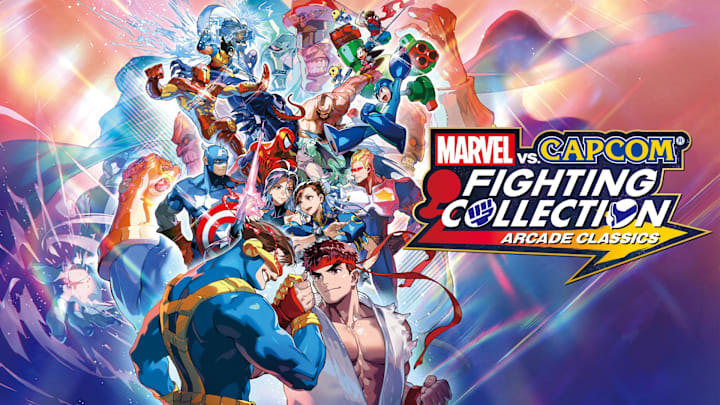Marvel vs Capcom Fighting Collection review: an essential collection

If you’re not a fighting game fan, then it’s hard to describe exactly how desperate the community has been for a port of Marvel vs Capcom 2. Online campaigns were launched, hashtags trended, influencers who barely knew how to perform a Hadouken were caught up in the fever, and the gaming community collectively begged Capcom to do a deal that would reunite Ryu with Wolverine – and the demands only increased after Marvel vs Capcom: Infinite launched without any of the X-Men.
Again, to give any newcomers in the audience an idea of how big a deal that is, this franchise was only possible thanks to Capcom’s X-Men: Children of the Atom, which would later influence X-Men vs Street Fighter. When die-hard fans think about Marvel vs Capcom, they think about Cyclops’ laser eyes and Wolverine’s snikty-snikt Shoryukens. But because Marvel overlords Disney saw Infinite as a marketing opportunity for the MCU, any characters that 20th Century Fox had the movie rights for were a no-go, slicing iconic characters out of a franchise they’re responsible for. Couple that with Infinite’s intensely underwhelming visuals and story cinematics, and it’s no wonder that fans wanted to return to tradition.
Since that entire debacle, the world of the MCU has shifted. Disney is becoming a force of nature, absorbing Fox along with any lingering Marvel movie rights and other iconic characters, like The Simpsons. This paved the way for the recent Deadpool & Wolverine, opening the doors of the MCU for the X-Men at last, and also releasing them from video game prison.
That was a long history lesson, I know, but it’s all to say one thing: this seemingly simple release of seven arcade games feels monumental. It’s been an incredibly long road, but we’re finally here. If you’re on PC or PlayStation, it means you can now play every Marvel X Capcom game on a single platform – and an Xbox release is coming down the line, too. The newest game in this collection is now over 24 years old, but against all odds, they play as if they’re brand new, much better than SNK vs. Capcom: SVC Chaos.
Playing through each game in order of release has the same vibe as flicking through the artwork in the Museum mode. There’s a clear throughline from X-Men: Children of the Atom to Marvel vs Capcom 2, with the developers tweaking their approach with each game, whether that’s using four buttons or six, having no tag partners or two, the introduction of assists, and more.
Children of the Atom simply feels like Street Fighter but with X-Men characters and more aerial options, but that quickly gets iterated on and becomes the style for the entire series. It’s about getting in and using a launcher attack to knock your foe into the stratosphere, at which point you jump up and begin stringing together aerial strikes. That sums up the whole series, but each game in this collection takes a different approach to that concept. Those earlier games in the series may have fewer options and abilities to play with, but like Street Fighter 2, that makes them more appealing for some players.
The evolution from X-Men: COTA, to Marvel Super Heroes, to the vs Street Fighter games, and finally to Marvel vs Capcom is fascinating to see and experiment with, and MvC2 really feels like the culmination of everything the team tried to achieve. No expense was spared in regards to the roster, the 3D backgrounds were some of the best looking of the era, and modern fighting games still struggle to look and feel this good to play.
The odd duck in the collection is The Punisher, a surprisingly fun beat-em-up starring – try to act surprised – The Punisher, and his pal Nick Fury. Despite not being a fighting game, seeing The Punisher beat, shoot, and stab bad guys as he stomps through the streets is probably the most violent thing in the entire collection. This is the game I was least excited about, but it’s possibly the game I’m most eager to revisit with a friend. It might not be a fighting game, but I’m glad Capcom found a home for it in this Marvel collection.
All of the fighting games come with rollback netcode for online matchmaking – both Ranked and Casual modes – and you can play The Punisher in co-op, too. You can also jump into a training mode that will show hit and hurtboxes, or look through a Museum mode filled with concept and character art that you have probably never seen at such a high resolution.
The Marvel X Capcom games have never been lazy crossovers – they’ve always felt like quality titles, and they’re held in a higher regard than many of the Street Fighter games for a lot of ‘90s-era arcade heads. I have to point that out because they’re all from the era of lazy licensed titles, and yet they’re better than most of the triple-A licensed games that are releasing on PS5 right now.
It’s refreshing to play a crossover game where every character is treated with a high level of care and adoration, but that’s exactly what this entire collection represents. If I’m being picky I’ll say that not every character’s sprite has been updated from game to game, and some can look uneven by the time MvC2 rolls around, but it feels like such a minor gripe compared to everything this collection represents.
Marvel vs Capcom Fighting Collection: Arcade Classics is an intensely unwieldy name, but it’s a hearty collection of some of the best arcade games Capcom ever made. If you’re a fighting game fan or an arcade nostalgic, you owe it to yourself to play Marvel vs Capcom Fighting Collection.
Score: 9/10
Platform: PS4
